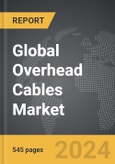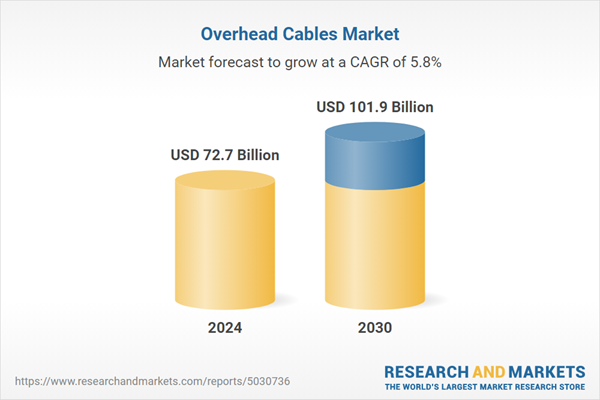Global Overhead Cables Market - Key Trends & Drivers Summarized
Overhead cables, also known as aerial cables, are critical components in the transmission and distribution of electrical power. These cables are suspended above the ground using poles or towers and are typically used to deliver electricity from power plants to substations and eventually to homes and businesses. Overhead cables come in various types, including bare conductors, insulated conductors, and bundled conductors, each designed for specific applications and environmental conditions. The primary materials used in these cables are aluminum and copper, chosen for their excellent conductivity and durability. Overhead cables are preferred for their cost-effectiveness, ease of installation, and ability to span long distances with minimal support structures. They play a vital role in ensuring a reliable and efficient power supply, especially in rural and remote areas where underground cables would be impractical.Technological advancements have significantly enhanced the performance and reliability of overhead cables. Innovations in materials science have led to the development of high-strength aluminum alloys and composite cores, which provide greater tensile strength and resistance to environmental stresses such as wind, ice, and temperature fluctuations. These advancements have enabled the design of overhead cables that can carry higher loads and withstand harsher conditions, reducing the risk of outages and maintenance requirements. Additionally, the integration of smart grid technologies has improved the monitoring and management of overhead cable networks. Sensors and automated systems can now detect faults and optimize load distribution in real-time, enhancing the overall efficiency and resilience of the power grid. Furthermore, advancements in insulation materials have improved the safety and reliability of insulated overhead cables, making them suitable for use in densely populated urban areas where space and safety are major concerns.
The growth in the overhead cables market is driven by several factors. The increasing global demand for electricity, driven by population growth and industrialization, is creating a significant need for robust and efficient power transmission and distribution infrastructure. The expansion of renewable energy projects, such as wind and solar farms, requires extensive overhead cable networks to connect these remote installations to the grid. Technological advancements in cable materials and smart grid integration are making overhead cables more reliable and efficient, encouraging their adoption. Additionally, government initiatives and investments in modernizing aging power infrastructure are boosting the demand for overhead cables. The growing emphasis on reducing transmission losses and improving energy efficiency is also driving the market, as overhead cables offer a cost-effective solution for long-distance power transmission. Lastly, the rapid urbanization and development of new residential and commercial areas are creating a need for expanded and upgraded power distribution networks, further fueling the market growth. Together, these factors are fostering a dynamic and expanding market for overhead cables, presenting significant opportunities for innovation and development.
Report Scope
The report analyzes the Overhead Cables market, presented in terms of market value (USD). The analysis covers the key segments and geographic regions outlined below.- Segments: Type (Low Voltage, Medium Voltage, High Voltage); Application (Residential, Utility, Commercial, Industrial).
- Geographic Regions/Countries: World; USA; Canada; Japan; China; Europe; France; Germany; Italy; UK; Spain; Russia; Rest of Europe; Asia-Pacific; Australia; India; South Korea; Rest of Asia-Pacific; Latin America; Argentina; Brazil; Mexico; Rest of Latin America; Middle East; Iran; Israel; Saudi Arabia; UAE; Rest of Middle East; Africa.
Key Insights:
- Market Growth: Understand the significant growth trajectory of the Residential Application segment, which is expected to reach US$40.6 Billion by 2030 with a CAGR of 6.7%. The Utility Application segment is also set to grow at 4.6% CAGR over the analysis period.
- Regional Analysis: Gain insights into the U.S. market, valued at $12.5 Billion in 2024, and China, forecasted to grow at an impressive 7.2% CAGR to reach $25.7 Billion by 2030. Discover growth trends in other key regions, including Japan, Canada, Germany, and the Asia-Pacific.
Why You Should Buy This Report:
- Detailed Market Analysis: Access a thorough analysis of the Global Overhead Cables Market, covering all major geographic regions and market segments.
- Competitive Insights: Get an overview of the competitive landscape, including the market presence of major players across different geographies.
- Future Trends and Drivers: Understand the key trends and drivers shaping the future of the Global Overhead Cables Market.
- Actionable Insights: Benefit from actionable insights that can help you identify new revenue opportunities and make strategic business decisions.
Key Questions Answered:
- How is the Global Overhead Cables Market expected to evolve by 2030?
- What are the main drivers and restraints affecting the market?
- Which market segments will grow the most over the forecast period?
- How will market shares for different regions and segments change by 2030?
- Who are the leading players in the market, and what are their prospects?
Report Features:
- Comprehensive Market Data: Independent analysis of annual sales and market forecasts in US$ Million from 2024 to 2030.
- In-Depth Regional Analysis: Detailed insights into key markets, including the U.S., China, Japan, Canada, Europe, Asia-Pacific, Latin America, Middle East, and Africa.
- Company Profiles: Coverage of players such as Amphenol Corporation, Alan Wire Company, Alpha Wire, ABL Electronic Supplies, Inc., AEI Cables Ltd. and more.
- Complimentary Updates: Receive free report updates for one year to keep you informed of the latest market developments.
Some of the 209 companies featured in this Overhead Cables market report include:
- Amphenol Corporation
- Alan Wire Company
- Alpha Wire
- ABL Electronic Supplies, Inc.
- AEI Cables Ltd.
- AFC Cable Systems, Inc.
- Allied Wire & Cable, Inc.
- Asia Pacific Wire & Cable Corporation Ltd.
- Asta Elektrodraht GmbH
- Atlas Wire LLC
- Backer-Springfield
- Badger Wire, Inc.
- Bay Associates Wire Technologies Corporation
- Baosheng Science & Technology Innovation Co., Ltd.
- ARi Industries, Inc.
This edition integrates the latest global trade and economic shifts into comprehensive market analysis. Key updates include:
- Tariff and Trade Impact: Insights into global tariff negotiations across 180+ countries, with analysis of supply chain turbulence, sourcing disruptions, and geographic realignment. Special focus on 2025 as a pivotal year for trade tensions, including updated perspectives on the Trump-era tariffs.
- Adjusted Forecasts and Analytics: Revised global and regional market forecasts through 2030, incorporating tariff effects, economic uncertainty, and structural changes in globalization. Includes historical analysis from 2015 to 2023.
- Strategic Market Dynamics: Evaluation of revised market prospects, regional outlooks, and key economic indicators such as population and urbanization trends.
- Innovation & Technology Trends: Latest developments in product and process innovation, emerging technologies, and key industry drivers shaping the competitive landscape.
- Competitive Intelligence: Updated global market share estimates for 2025, competitive positioning of major players (Strong/Active/Niche/Trivial), and refined focus on leading global brands and core players.
- Expert Insight & Commentary: Strategic analysis from economists, trade experts, and domain specialists to contextualize market shifts and identify emerging opportunities.
Table of Contents
Companies Mentioned (Partial List)
A selection of companies mentioned in this report includes, but is not limited to:
- Amphenol Corporation
- Alan Wire Company
- Alpha Wire
- ABL Electronic Supplies, Inc.
- AEI Cables Ltd.
- AFC Cable Systems, Inc.
- Allied Wire & Cable, Inc.
- Asia Pacific Wire & Cable Corporation Ltd.
- Asta Elektrodraht GmbH
- Atlas Wire LLC
- Backer-Springfield
- Badger Wire, Inc.
- Bay Associates Wire Technologies Corporation
- Baosheng Science & Technology Innovation Co., Ltd.
- ARi Industries, Inc.
Table Information
| Report Attribute | Details |
|---|---|
| No. of Pages | 545 |
| Published | December 2025 |
| Forecast Period | 2024 - 2030 |
| Estimated Market Value ( USD | $ 72.7 Billion |
| Forecasted Market Value ( USD | $ 101.8 Billion |
| Compound Annual Growth Rate | 5.8% |
| Regions Covered | Global |









